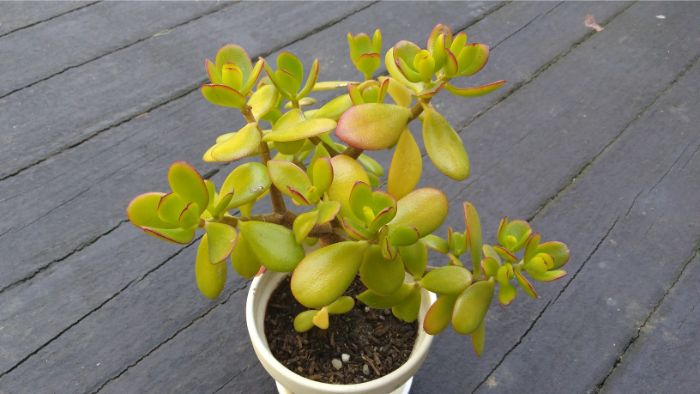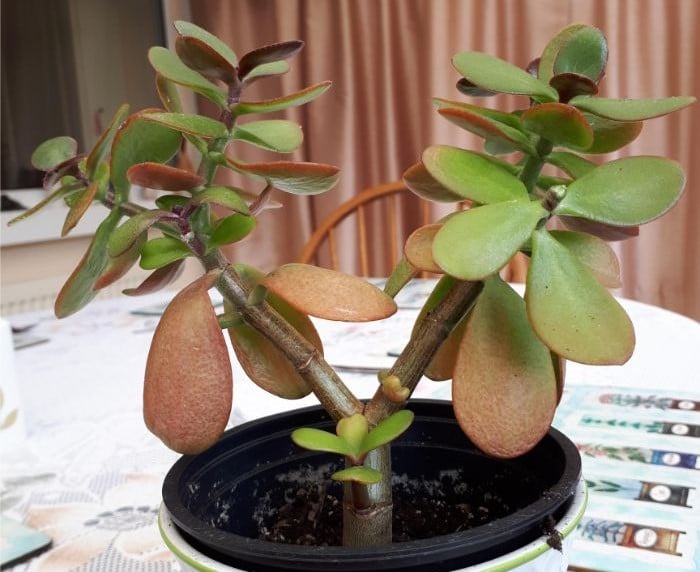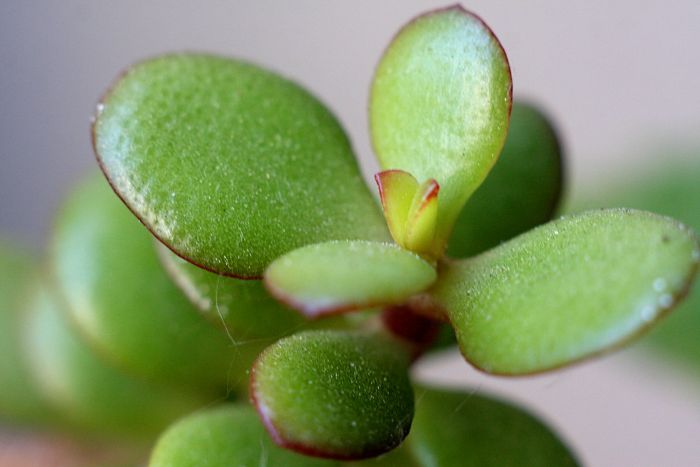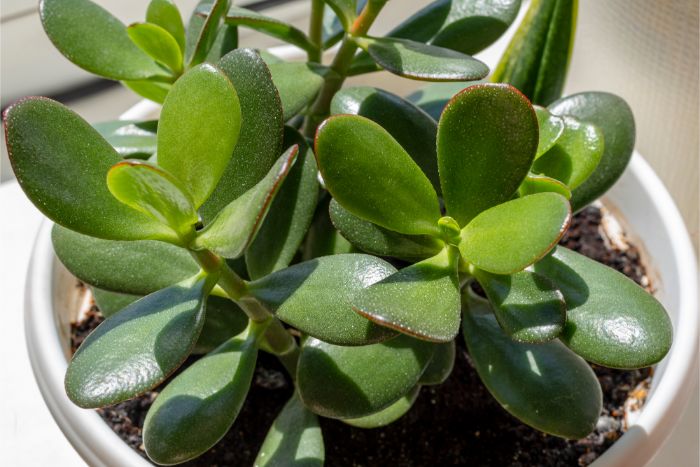One of the most common problems with Jade Plants (Crassula ovata) is giving them too much water. It’s so easy to be a little overenthusiastic with the watering can when trying to help your Jade Plant thrive. This article will tell you the signs of Jade Plant overwatering and how to fix and prevent them.
Jade Plant Overwatering Symptoms: The symptoms of overwatering a Jade Plant are yellowing leaves, leaf drop, soft leaves and dry leaves. The soil will usually be waterlogged and the roots will show signs of root rot.
Follow the tips and advice below to identify an overwatered Jade Plant and learn how you can treat and revive it. For more general jade plant care tips, I’ve written a complete guide to jade plant care.
Jade Plant Overwatering Symptoms Explained
A Jade plant that is overwatered shows very similar signs to what you would expect from an underwatered plant – signs of dehydration.
While it can seem a little confusing at first, once you understand what happens to an overwatered Jade Plant, it all makes sense.
Overwatering a Jade Plant causes root root and root death, which prevents the plant from being able to absorb water and nutrients. So you can see that two very different watering problems can cause similar symptoms.
It’s crucial that you are able to tell the two problems apart if you want to fix your Jade plant and prevent similar problems in the future. Below is a brief explanation of each of the symptoms of Jade plant overwatering.
An Overwatered Jade Plant May Have Yellowing Leaves
One of the first signs of overwatering a Jade plant is the yellowing of its leaves. Sometimes older leaves can turn yellow as they are replaced by new growth, but if your plant has many yellow leaves, then there is a problem that needs fixed.
The leaves turn yellow as a result of overwatering because the rots are waterlogged, may be suffering from root rot, and the plant is not able to absorb sufficient nutrients to thrive and flourish.
If your Jade Plant is getting yellow leaves, this is an opportunity to identify the cause of the problem and fix it before your plant suffers further. Yellow leaves can be caused by a whole range of issues, such as overwatering, underwatering, high or low temperatures, pests and disease.
This means you will need to investigate things a bit further before you take action to fix the problem.

Leaf Drop Can Be Caused By Overwatering
Leaf drop can occur whenever an overwatering problem becomes worse. As the Jade Plant’s root system struggles further, it cannot support the leaves, which leads to leaf drop.
If your Jade plant is dropping older leaves as they mature, this is not always a sign of overwatering. It could be absolutely normal. Keep an eye out for excessive or premature leaf dropping as a sign of too much water.
Soft Leaves Is A Symptom Of Overwatering Your Jade Plant
Your first thought when you squeeze a Jade Plant’s leaves and find them soft is probably that the plant is dehydrated and needs more water. This is not always the case though, so don’t jump to watering it immediately.
A healthy Jade plant has water-filled leaves that are thick and firm to the touch. If the leaves of your Jade plant are more soft and “squishy” than they are firm, it could be a sign that the plant is being overwatered.
Soft leaves often present themselves when the Jade plant suffers root rot, which is directly caused by excessive watering. However, soft leaves can also be a sign of underwatering or dehydration, so you may not be wrong if you first thought as much.
The best way to determine if the leaves are soft from overwatering or underwatering is to check the roots and soil.
Very Dry Leaves Can Be A Sign of Overwatering Your Jade Plant
Very dry leaves on your Jade Plant might prompt you to believe that the plant is dehydrated or in need of watering. While it is natural to think this and reach for the watering can, you might be making a mistake.
In keeping with the other symptoms, dry leaves can indicate an overwatered Jade Plant due to non-functioning roots.
Wet Soil And Root Rot
This might seem obvious, but the condition of the soil, in combination with the symptoms of the plant is what will help you identify the cause of your plant’s problems.
Saturated soil will quickly cause root rot, which can kill the roots of your plant, preventing your Jade Plant absorbing water and nutrients. Without water and nutrients, the plant becomes dehydrated and shows signs of nutrient deficiency.
Feel the soil with your fingers to assess the moisture. If the soil is saturated and the pot is heavy with water, then it is very unlikely that underwatering is the cause of the problem.
If the soil is saturated, and your plant is looking unhealthy, you should lift the plant out of it’s pot to take a closer look at the roots. If the roots appear wet, soft and mushy, overwatering is most-likely the culprit.

How Do You Revive An Overwatered Jade Plant?
Once your Jade plant starts showing signs of being “sick”, you might worry that there is no way to save it. Luckily, an overwatered Jade plant can be revived and recovered fairly easily if you act quickly.
If your Jade plant is showing signs of overwatering, it is best to act as quickly as possible to save it.
Below are a few things that you can do:
Remove The Waterlogged Soil
The most important thing to do with a waterlogged Jade Plant is to improve conditions for the roots. You should remove the plant from the pot and gently remove as much of the waterlogged soil from around the roots.
You’ll then need to assess the health of the roots. Drastic action may be needed.
Remove The Most Affected Rotting Roots
Root rot can spread throughout the entire root system and even into the stem of the Jade plant. Your Jade plant’s rotting roots should be pruned back using sterile pruning shears.
How much should you cut off? When you cut the root, the inside should be entirely white, if it is expected to survive. If you see any brown coloring in the center of the root, keep cutting it back until it is completely white.
Once you have done this, and the Jade plant only has healthy roots left, you can make another cut into each of the healthy roots, which will encourage new root growth and hopefully help the plant to bounce back.
Make sure that you sterilize your pruners after removing root rot areas. This can be done by wiping them with rubbing alcohol or holding the blades under a flame for a few seconds.
Repot The Plant
You can now repot your Jade Plant into a more suitable living environment. Choose a container that is appropriately sized for your plant. A pot that is just large enough to accommodate the root structure of the plant is perfect. Avoiding a pot that is too large will allow the soil to dry out quicker.
It is essential to use fresh, dry potting mix when repotting your Jade plant. The soil must be fast draining to reduce the risk of overwatering in the future.
Opt for creating your own soil mix for the best results. A good mix is equal parts potting soil, coarse sand and perlite. You can also use cactus soil or succulent potting soil for convenience.
Don’t water the plant for a few days. Only do so when the plant looks like it might be pepping up a bit or when the roots and soil feel completely dry. When you start watering the plant again, make sure that you don’t overdo it.
Only water the Jade plant when the soil has completely dried out. This may only be once every few weeks depending on the conditions in your home.

Best Practice To Avoid Jade Plant Overwatering Issues
While there are things that you can do to recognize, diagnose, treat, and revive symptoms of overwatering, it is often better to look at preventative care strategies.
The best way to ensure that your Jade plant doesn’t suffer any of the symptoms of overwatering is to ensure that you don’t overwater it in the first place (or subject it to poor drainage conditions).
The most important thing is to check the soil of your Jade plant before watering to ensure that it is sufficiently dry and that more water is required. There are a number of ways of checking to see if your houseplant needs watered, such as testing the soil with your finger, or checking the weight of the pot to estimate how dry the potting soil is.
If you want to learn more, I’ve written an article all about how to tell when your houseplants need watered.
Tips For Creating A Happy Jade Plant Environment
First and foremost, look at creating a happy and healthy environment for your Jade plant. This should include a good potting, watering, and maintenance schedule.
You can also use the following tips to ensure that the living environment for your Jade plant is good or suitable:
Pot Your Jade Plant Correctly From The Start
If you start off well with your Jade plant, you will only have to maintain it and not work so hard at recovering and reviving it. It all starts with how you initially pot the plant.
The soil and the pot that you use for your Jade plant can impact on how much water it has to deal with. If the pot doesn’t drain well or the soil tends to waterlog, your Jade plant will be forcibly overwatered.
When potting your Jade plant, ensure that the container has plenty of drainage holes and that the soil doesn’t block them every time you water the plant. Increase drainage by adding some perlite into the soil mix.
Get Rid Of Excess Water From The Drip Tray
If your Jade plant’s pot has a drip tray, you might find that water drains out of the pot and settles in it every time that you water it. This means that your soil is draining well and that the pot’s holes aren’t clogged – it’s good news!
It is however important to promptly get rid of excess water from the saucer so that the Jade plant doesn’t sit in it for an extended period of time. As you might guess, this can cause root rot! Once you have watered your succulent, wait about 30 minutes and then empty the saucer out.
Quickly Rectify Overwatering Mistakes
Providing a little too much water every now and then won’t do your Jade plant much harm, but repeated overwatering will cause problems.
If you think there is a problem, stop and assess the situation. Consider the factors we have discussed in this article and make some adjustments to prevent your plant from suffering.
Replace Poorly Draining Soil Promptly
It is easy to overlook the problem of poor-quality soil. If your potting mix isn’t draining like it should, it will compromise the health of your Jade plant’s root system. If the soil doesn’t seem to drain, you need to improve the drainage or repot your Jade Plant with better draining potting mix.
Last Word
When you first see the tell-tale signs of overwatering, you might think it is already too late to save your favorite house plant. The good news is that there are a number of things you can do to revive your Jade plant and get it flourishing happily once more.
Make sure that you set up an ideal living environment for your Jade plant from the start and you may never face the problems of overwatering.

